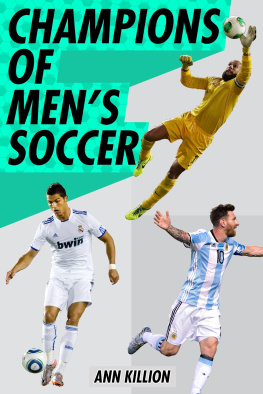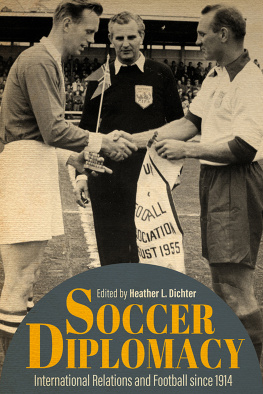SOCCER IN AMERICAN CULTURE
ALSO BY G. EDWARD WHITE
The Eastern Establishment and the Western Experience (1968)
The American Judicial Tradition (1976)
Patterns of American Legal Thought (1978)
Tort Law in America: An Intellectual History (1980)
Earl Warren: A Public Life (1982)
The Marshall Court and Cultural Change (1988)
Justice Oliver Wendell Holmes: Law and the Inner Self (1993)
Intervention and Detachment: Essays in Legal History and Jurisprudence (1994)
Creating the National Pastime: Baseball Transforms Itself, 19031953 (1996)
Oliver Wendell Holmes: Sage of the Supreme Court (2000)
The Constitution and the New Deal (2000)
Alger Hiss Looking-Glass Wars (2004)
Oliver Wendell Holmes, Jr. (2006)
History and the Constitution: Collected Essays (2007)
Law in American History: Volume 1, From the Colonial Years through the Civil War (2012)
American Legal History: A Very Short Introduction (2014)
Law in American History: Volume 2, From Reconstruction through the 1920s (2016)
Law in American History: Volume 3, 19302000 (2019)
(with Kenneth S. Abraham) Tort Law and the Construction of Change: Studies in the Inevitability of History (2022)
Copyright 2022 by The Curators of the University of Missouri
University of Missouri Press, Columbia, Missouri 65211
Printed and bound in the United States of America
All rights reserved. First printing, 2022.
Library of Congress Cataloging-in-Publication Data
Names: White, G. Edward, author.
Title: Soccer in American culture : the beautiful games struggle for status / G. Edward White.
Description: Columbia : University of Missouri Press, 2022. | Series: Sports and American culture | Includes bibliographical references and index.
Identifiers: LCCN 2021048528 (print) | LCCN 2021048529 (ebook) | ISBN 9780826222534 (hardcover) | ISBN 9780826274700 (ebook)
Subjects: LCSH: Soccer--United States--History. | Soccer--Social aspects--United States
Classification: LCC GV944.U5 W55 2022 (print) | LCC GV944.U5 (ebook) | DDC 796.3340973--dc23/eng/20211020
LC record available at https://lccn.loc.gov/2021048528
LC ebook record available at https://lccn.loc.gov/2021048529
 This paper meets the requirements of the American National Standard for Permanence of Paper for Printed Library Materials, Z39.48, 1984.
This paper meets the requirements of the American National Standard for Permanence of Paper for Printed Library Materials, Z39.48, 1984.
Typefaces: Adobe Garamond Pro and Aktiv Grotesque
Sports and American Culture
Adam Criblez, Series Editor
This series explores the cultural dynamic between competitive athletics and society, the many ways in which sports shape the lives of Americans in the United States and Latin America, from a historical and contemporary perspective. While international in scope, the series includes titles of regional interest to Missouri and the Midwest. Topics in the series range from studies of a single game, event, or season to histories of teams and programs, as well as biographical narratives of athletes, coaches, owners, journalists, and broadcasters.
For Elisabeth White Varadhachary
Illustrations
Preface
THIS VOLUME IS analogous to my 1996 book Creating the National Pastime, a study of the history of major-league baseball, in three respects. First, it is a venture in sports history, containing comparatively little coverage of legal issues, and in that respect is a departure from my usual scholarly concerns. Second, it focuses on a sport in which I have spent a fair amount of my life as a player and coach. And third, it represents something of a break, or perhaps a treat, after a long interval of scholarship on legal and constitutional history. I began work on Creating the National Pastime after one such interval, which took place from around 1983 to 1993; and turned to this book after another, from around 2009 to 2019. I am of the view that one of the ways to stimulate the consistent production of scholarship over time is to change topics, time frames, and methodological approaches as one sequences scholarly projects. As my colleagues have often noted, I like to learn through researching and writing, and one way I do that is by identifying topics and approaches with which I am generally unfamiliar and seeking to say something distinctive about them. I have learned a lot in writing this book, and I hope I have been able to make a contribution to the understanding of its subjects.
Because the history of American soccer has been a generally underresearched topic, especially by scholars, and because many of the secondary works in the area lack scholarly documentation, this book has been something of a research challenge, and I have had to rely even more heavily than usual on the help of the reference librarians at the University of Virginia School of Law. Thanks to Amy Wharton, Kent Olson, Leslie Ashbrook, Randi Flaherty, Ben Doherty, and Kristin Glover for tracking down sources, a task made more complicated by the pandemic and its effect on interlibrary loans. Thanks as well to Loren Moulds for his assistance in identifying illustrations and facilitating permissions for images. And a special thanks to the LawIT department for their multiple Team Viewer sessions, in which I received various sorts of technical help. I am one of their least competent clients, and I appreciate their patience.
Kenneth S. Abraham and Neil Duxbury each read an early draft of the book manuscript and gave me helpful comments. Persons familiar with their scholarship might initially wonder what qualified them to opine on the subjects covered in the book, but they each bear a connection to the history of soccer in England and America. Ken grew up in one of the communities where soccer was first played in the United States, and Neil is a resident of a UK city hosting two of the worlds best-known soccer clubs (and a far less celebrated club of which he is unfortunately enamored). I leave it to readers to attempt to guess the respective locations, if they feel the need for a break from the books text.
The book has been immeasurably improved by the efforts of Adam Criblez, the editor of the University of Missouri Press series Sports and American Culture in which it appears, and Andrew Davidson, editor in chief of the press. Both Adam and Andrew read successive drafts of the book manuscript and gave me line-by-line comments, as well as made suggestions about the overall scope and content of the work. I also profited from the comments of Steven Reiss on an earlier draft and two anonymous readers of the penultimate draft. I want to emphasize the contributions of Adam and Andrew, however, because it has been a very long time in my publishing history since someone associated with a university press has engaged in the close reading and editing of one of my manuscript drafts. When I first submitted book manuscripts to university presses, in the late 1960s, such reading and editing was the norm, but with the dramatic changes in book publishing that have taken place since that decade, it is now quite rare. I lament its lossthere is nothing more helpful to an author than to have engaged, critical readings of manuscript draftsand have welcomed Adams and Andrews interventions.
This book is dedicated to my younger daughter Elisabeth, once a soccer player who had to endure her father as her high school coach for three years. Perhaps Elisabeths daughters will become attracted to the sport and Elisabeth will end up coaching them. And my love to Susan Davis White, Alexandra White, and the other members of the Whites extended family, who hopefully will be safe, healthy, and able to see one another in person by the time this book appears.















 This paper meets the requirements of the American National Standard for Permanence of Paper for Printed Library Materials, Z39.48, 1984.
This paper meets the requirements of the American National Standard for Permanence of Paper for Printed Library Materials, Z39.48, 1984.